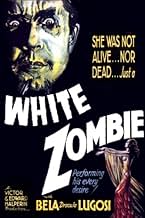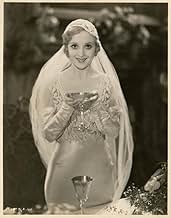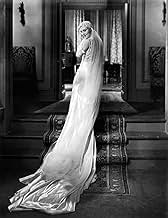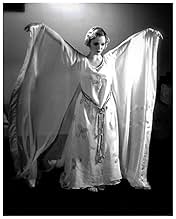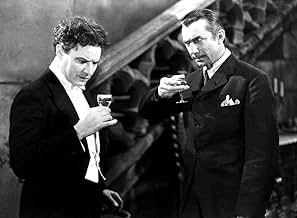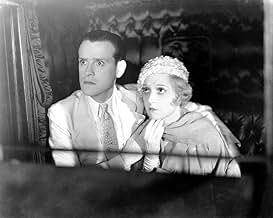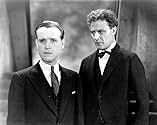IMDb-BEWERTUNG
6,2/10
12.247
IHRE BEWERTUNG
Ein junger Mann wendet sich an einen Hexendoktor, um die Frau, die er liebt, von ihrem Verlobten wegzulocken, doch stattdessen verwandelt er sie in eine Zombie-Sklavin.Ein junger Mann wendet sich an einen Hexendoktor, um die Frau, die er liebt, von ihrem Verlobten wegzulocken, doch stattdessen verwandelt er sie in eine Zombie-Sklavin.Ein junger Mann wendet sich an einen Hexendoktor, um die Frau, die er liebt, von ihrem Verlobten wegzulocken, doch stattdessen verwandelt er sie in eine Zombie-Sklavin.
John T. Prince
- Ledot - Zombie
- (as John Printz)
Clarence Muse
- Coach Driver
- (Nicht genannt)
Empfohlene Bewertungen
This review will be more about the print and theatrical experience than about the plot. Most people won't find this "useful", but hey, so what. Here's my two cents.
If you have the opportunity to see the Roan Group print projected in a theater, don't hesitate. Go see it.
I just saw this in the big screen last weekend and it is MUCH better in a proper theater with a crowd of enthusiasts than in the confines of your home, even with a big TV and 5.1. The audience I was in was comprised of about 150 kids and their parents. The kids had a great time as did I, who has seen the movie several times over the years in the washed out public domain video prints that have circulated forever.
The Roan Group print (same as the remastered DVD) is the one we saw, projected in 35 mm. It was obvious that there were two sources for this print. The vast majority of this appears to come from a very nice print with high contrast and sharp definition. The "fill-in" portions, apparently missing from the other source, are much more typical of a 75-year-old cheapie independent production shot in 11 days, i.e., scratchy, multiple generations removed from the negative, and faded. Thankfully there's not too much from that second source. There are a few jumps in the film (a few seconds at most) that could not be restored. Too bad, but no biggie.
The sound was problematic, veering from a comfortable volume when dialogue was speaking, to way too loud, almost to the point of distortion, when the music played or the bird squawked. I really don't think it was the theater's fault as their sound is always "just right".
Interestingly, for a movie this old (pre King Kong and Bride of Frankenstein) there was a whole lot of music and not as much dialogue as one usually gets in a film from this era. The music was rarely background to dialogue and was used almost exclusively to enhance the mood of the film. It was probably cheaper to do it this way, but who cares why. It works.
This is a really neat film full of great shots and creepy characters. Bela is fantastic, maybe his best performance on film. White Zombie hardly ranks up there with the Universal classics of the era, but it is positively time for a historical and critical reappraisal of this newly restored film.
It's good on video, but on the big screen, WOW!
If you have the opportunity to see the Roan Group print projected in a theater, don't hesitate. Go see it.
I just saw this in the big screen last weekend and it is MUCH better in a proper theater with a crowd of enthusiasts than in the confines of your home, even with a big TV and 5.1. The audience I was in was comprised of about 150 kids and their parents. The kids had a great time as did I, who has seen the movie several times over the years in the washed out public domain video prints that have circulated forever.
The Roan Group print (same as the remastered DVD) is the one we saw, projected in 35 mm. It was obvious that there were two sources for this print. The vast majority of this appears to come from a very nice print with high contrast and sharp definition. The "fill-in" portions, apparently missing from the other source, are much more typical of a 75-year-old cheapie independent production shot in 11 days, i.e., scratchy, multiple generations removed from the negative, and faded. Thankfully there's not too much from that second source. There are a few jumps in the film (a few seconds at most) that could not be restored. Too bad, but no biggie.
The sound was problematic, veering from a comfortable volume when dialogue was speaking, to way too loud, almost to the point of distortion, when the music played or the bird squawked. I really don't think it was the theater's fault as their sound is always "just right".
Interestingly, for a movie this old (pre King Kong and Bride of Frankenstein) there was a whole lot of music and not as much dialogue as one usually gets in a film from this era. The music was rarely background to dialogue and was used almost exclusively to enhance the mood of the film. It was probably cheaper to do it this way, but who cares why. It works.
This is a really neat film full of great shots and creepy characters. Bela is fantastic, maybe his best performance on film. White Zombie hardly ranks up there with the Universal classics of the era, but it is positively time for a historical and critical reappraisal of this newly restored film.
It's good on video, but on the big screen, WOW!
There's something about 1930s horror movies that makes them really special and haunting. It's probably got a lot to do with the talkies being new and directors being free to experiment with tricks learned from German expressionism. Whatever the explanation the best movies from the early 30s (James Whale's 'Frankenstein', 'Bride Of Frankenstein' and 'The Invisible Man', Todd Browning's 'Dracula' and 'Freaks') have a dreamlike quality that sticks in your brain and just won't leave. Bela Lugosi is one of the icons of horror movies. He made 'White Zombie' not long after 'Dracula', his definitive role, and gives another great performance. 'Island Of Lost Souls' is a better movie than 'White Zombie' but Lugosi on has a small role in that so I'd say this is his best movie after 'Dracula'. It's easy to forget just how quickly his career died. His two mid-30s teamings with Boris Karloff ('The Black Cat' and 'The Raven') were basically the beginning of the end for him as a major star, and by the time he played Ygor in the underrated 'Son Of Frankenstein' at the end of the decade he was almost a has been. Oh well Lugosi is just terrific in this movie as the sinister 'Murder' Legrende, Haitian mill owner and zombie master. Robert Fraser plays Charles Beaumont, a local plantation owner who becomes obsessed with a young woman (Madge Bellamy) about to be married. He invites her and her fiance (John Harron) to his estate to have their wedding all the while planning some way to win her. An hour before the wedding he becomes desperate and reluctantly approaches his sinister neighbour Legrende. Legrende's solution has dire consequences for all involved. The movie was obviously made a shoe string budget but there are plenty of striking visual images, especially those involving Bellamy after Lugosi gets to her. The zombies are very creepy and are the precursors to zombie classics later made by Tourneur, Romero, Fulci and Raimi. For this and for Lugosi 'White Zombie' is a must see for any horror buff!
WHITE ZOMBIE is one of those rare early talkies where everything fits just right. Rumours have circulated for years that Bela Lugosi himself actually directed part, if not all, of the movie. Having seen all of the movies made by the Halperin Brothers in the 30's this is deffinitely the best, but DID Bela direct it? There is a quality in this film lacking from all other Halperin films. In many scenes the technique seems to have been borrowed from German silent films and Bela did work with Edgar Ulmer in Germany early in his career. Also notice that WHITE ZOMBIE is essentially a silent film with key scenes performed with a minimum of dialogue . . .or none at all; a standout moment is when Legendre (Bela Lugosi) traps the soul of Madeline (Madge Bellamy) by carving, and then melting, a wax image in her likeness. All without a single word being said. Another key sequence is a montage of scenes set against the haunting spiritual "Listen To The Lambs" performed by an offscreen chorus. Notice also the scene where Neil (John Harron, brother of former silent film star Robert Harron) and Dr. Bruner (Joseph Cawthorn) are talking. The camera starts out behind Harron's back and moves out. It moves in a circle around the room while the men talk and finally goes back behind Harron to end the scene; deffinitely an Expressionist Germanic touch! Granted the film has its flaws, Joseph Cawthorn's character is supposed to be to be a Christian missionary but he has a noticably Yiddish accent. Also for a film that is set in Haiti there is an uncomfortable lack of black characters. Clarence Muse as the coach driver is the only one in the movie! Two other alleged native Haitians are white actors in blackface! Madge Bellamy's bee-stung lips and eye makeup also belong back in a silent film. Weighed against the film as a whole however, these inadequacies are slight. The cast is quite good. Robert Fraser met up with Lionel Atwill in THE VAMPIRE BAT (1934). Clarence Muse met up with Bela again in THE INVISIBLE GHOST (1944). One of the zombies is played by George Burr McAnnan who had played the puritannical leader of the farm community that ostracises unwed mother Lillian Gish in WAY DOWN EAST (1920). Also look for Brandon Hurst as a creepy looking butler. He had played the evil Jehan Frollo opposite Lon Chaney's Quasimodo in THE HUNCHBACK OF NOTRE DAME (1923). By all means see this movie! It is well worth your time. So did Bela direct it? Alas we may never know. Then again, in an interview given in the early 1970's Clarence Muse said he clearly recalled Bela directing a few scenes. So maybe . . .
Sometimes silly, sometimes stilted, nearly always stagey, White Zombie remains nonetheless one of the most visually fascinating films in horror history. Who can forget the image of Madge Bellamy's alabaster gown flowing down the concrete staircase, or the zombie burial procession outlined spectrally against the sky, or the sinister shadows cast demonically across a dance floor. Then there's the magnificently Gothic hall with its grotesquely twisted bannister like none other I've seen. In fact, almost every scene presents at least one arresting visual feature. As good as these and the many other touches are, it's still the mill scene that remains a masterpiece of visual staging. It must be seen to be appreciated-- the pitiless grind of the crusher, the soundless shuffle circling into the maw-- all in all, one of the deeper levels of Dante's inferno and one that's bound to stay with you.
If the visuals are inspired, the acting is not. It's almost as if two different people are in charge. Bellamy is quite good with her large liquid eyes and bee-stung lips. Her transformation into a zombie stupor is well performed. Of course, there's also Lugosi as Lugosi, florid, hammy, but effective nonetheless. The other principals, however, bring down the proceedings with what can only be described as bad acting. Bellamy's swain in particular is plain annoying, while the preacher appears to have wandered in from a breezy Bing Crosby production. Too bad. With more appropriate performances this could have been an all-time classic.
As things stand, it's a truly memorable film, whose influence can be seen in such diverse venues as Val Lewton's horror cycle, Bergman's The Seventh Seal, and Romero's Night of the Living Dead. Except for the mill scene with its eerily grinding tonality, the movie might be best enjoyed by turning off the sound altogether. (P. S. Colorizing this b&w marvel is nothing less than a crime.)
If the visuals are inspired, the acting is not. It's almost as if two different people are in charge. Bellamy is quite good with her large liquid eyes and bee-stung lips. Her transformation into a zombie stupor is well performed. Of course, there's also Lugosi as Lugosi, florid, hammy, but effective nonetheless. The other principals, however, bring down the proceedings with what can only be described as bad acting. Bellamy's swain in particular is plain annoying, while the preacher appears to have wandered in from a breezy Bing Crosby production. Too bad. With more appropriate performances this could have been an all-time classic.
As things stand, it's a truly memorable film, whose influence can be seen in such diverse venues as Val Lewton's horror cycle, Bergman's The Seventh Seal, and Romero's Night of the Living Dead. Except for the mill scene with its eerily grinding tonality, the movie might be best enjoyed by turning off the sound altogether. (P. S. Colorizing this b&w marvel is nothing less than a crime.)
White Zombie is beautiful to watch, a combination of gorgeous black and white photography and wonderfully rendered matte paintings, and combo shots. I found the ending somewhat underwhelming, especially in light of some foreshadowing which does not pay off. Nonetheless, a true classic, even more fascinating if viewed through the lens of more informed understandings of colonialism, slavery, and related race relations.
Wusstest du schon
- WissenswertesWas a personal favorite of Bela Lugosi, according to his son, Bela Lugosi Jr..
- Patzer(at around 46 mins) The vulture manages to scream, loudly and repeatedly, with its beak shut.
- Zitate
Madeline: Driver, who were those men we saw?
Coach Driver: They are not men, madame. They are dead bodies!
- Crazy Credits"White Zombie starring Bela (Dracula) Lugosi."
- Alternative VersionenThe scene is which the zombie is crushed by the grinder, after falling into the chute in the factory, is missing from most available prints.
- VerbindungenEdited into Die Revolte der Zombies (1936)
- SoundtracksBridal Chorus (Here Comes the Bride)
(uncredited)
from "Lohengrin"
Music by Richard Wagner (1850)
Played on an organ for the wedding
Top-Auswahl
Melde dich zum Bewerten an und greife auf die Watchlist für personalisierte Empfehlungen zu.
- How long is White Zombie?Powered by Alexa
Details
- Erscheinungsdatum
- Herkunftsland
- Sprache
- Auch bekannt als
- Schreckenshaus der Zombies
- Drehorte
- Produktionsfirma
- Weitere beteiligte Unternehmen bei IMDbPro anzeigen
Box Office
- Budget
- 50.000 $ (geschätzt)
- Laufzeit1 Stunde 9 Minuten
- Farbe
- Seitenverhältnis
- 1.37 : 1
Zu dieser Seite beitragen
Bearbeitung vorschlagen oder fehlenden Inhalt hinzufügen

Oberste Lücke
By what name was Im Bann des weissen Zombies (1932) officially released in India in English?
Antwort


